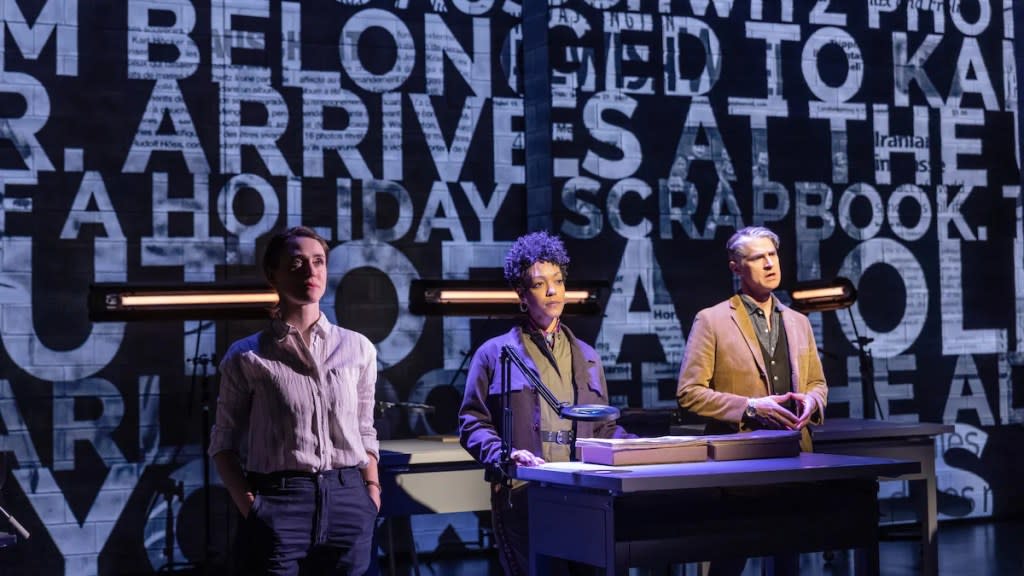‘Here There Are Blueberries’ Off Broadway Review: Revisiting Another ‘Zone of Interest’

It happens whenever a director decides to unspool a film or place blown-up photographs among live actors on stage. You can say all you want about the tremendous power of theater. When an audience is given the choice to follow the actors or a projection, the eye goes to the projection.
After its 2022 world premiere at La Jolla Playhouse, Moises Kaufman and Amanda Gronich’s play “Here There Are Blueberries” opened Monday at the New York Theatre Workshop, and the photographs projected on stage, taken at Auschwitz and its environs during World War II, are nothing short of unforgettable.
Late in “Here There Are Blueberries,” we see the more familiar photos. These are the images of Jews arriving by train at Auschwitz, surrounded by the Nazi guards and their dogs. They are shocking. But equally disturbing for very different reasons are the happy photographs displayed earlier in the play. These photographs include no images of Jewish prisoners, but rather the commandants and the employees of Auschwitz — and these Nazis are having a great time.
The men in uniform sing, picnic, enjoy a beer at the end of a long hard day at the concentration camp. Other photos show female telephone operators from Auschwitz being treated to a dessert of blueberries at Solahutte, a lodge retreat snuggled among the pine trees near Auschwitz. From another album, photographs show children enjoying themselves in a backyard pool. Only on closer inspection do we notice a guard tower at Auschwitz just over the ivy-covered wall.
These Nazis-having-a-good-time photos recall the Oscar-winning film “The Zone of Interest,” but are more disturbing because the people in the photographs are not actors. They were real people, and one can only wonder if the various photographers even had to say “smile” before taking the shot.
Hannah Arendt wrote “The Banality of Evil.”
“Here There are Blueberries” could be retitled “The Joys of Evil.”
David Bengali provides the “Blueberries” projection design, and Kaufman’s placement and display of those photographs is nothing short of brilliant. His direction of the actors and the text they speak, written with Gronich, is something less.
“Here There Are Blueberries” opens with a debate about whether an album of photographs found by the descendent of an Auschwitz commandant should be part of any exhibit at the United States Holocaust Memorial Museum. There’s a lot of talk among the archivists about the museum’s purpose; it’s to memorialize the victims of the concentration camps, not the people who ran those extermination centers.
There are two ways to look at this debate. On one level, it’s a way to gin up suspense. Will the museum take the photos or reject them? This debate comes off as completely bogus, because the photos are compelling at first glance and they provide a vital part of the story: Who were these fanatics and how could they murder six million Jews? The photos tell us they took pleasure in what they did. They may have even experienced joy.
If, in fact, there really was a serious debate whether these photographs should be included in the museum, then the directors of the Holocaust Memorial Museum should resign, if they haven’t already left the museum.
Playing museum archivists, the actors use the photographs to lead us through a history of perversion. Unfortunately, this dialogue is delivered with great drama. Only the legendary Kathleen Chalfant manages to bring a modicum of understatement to the production. Otherwise, the actors appear to be trying to upstage the photographs, which is impossible.
The weakest moments of the play come when the descendants of Nazis are interviewed. Most refuse to be interviewed, but those who do talk about their family’s notorious past have the canned, overly rehearsed quality of the interviews from one of Kaufman’s previous plays, “The Laramie Project,” about the murder of Matthew Shepard. There, the townspeople of Laramie, Wyoming, give a superficial retelling of what happened, too aware that their accounts will be consumed by an audience sympathetic to the gay teenager’s horrific fate. The interviews in “Here There Are Blueberries” also lack an interviewer who has the guts to probe beyond the simple apologies. An exception is the “bad seed” story about a descendant who thinks he’s passing on a Nazi gene to his children.
Kaufman and Gronich’s play was recently made a finalist for the Pulitzer Prize in drama. It is yet another example of a work of art being awarded for its subject matter, not its execution. That said, the photographs are worth a visit to the New York Theatre Workshop where “Here There Are Blueberries” is a coproduction with Tectonic Theater Project.
The post ‘Here There Are Blueberries’ Off Broadway Review: Revisiting Another ‘Zone of Interest’ appeared first on TheWrap.

